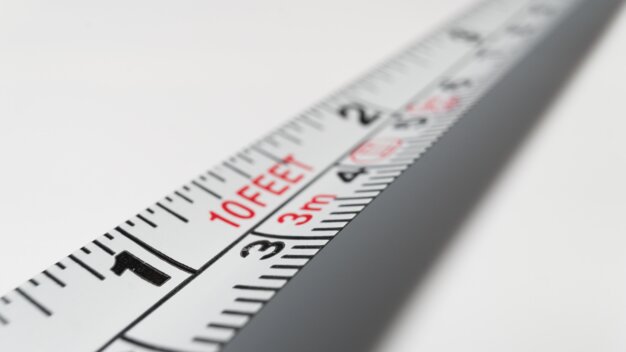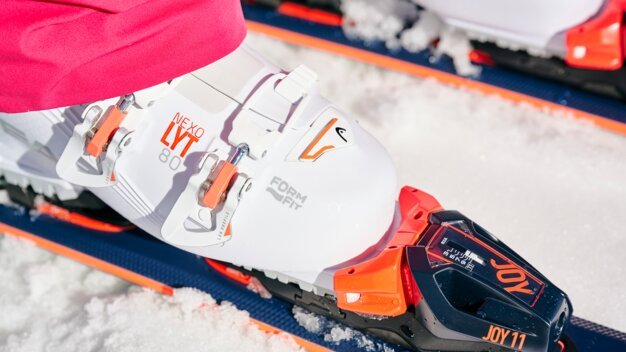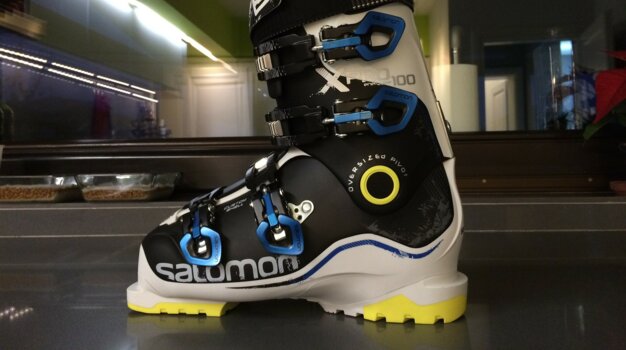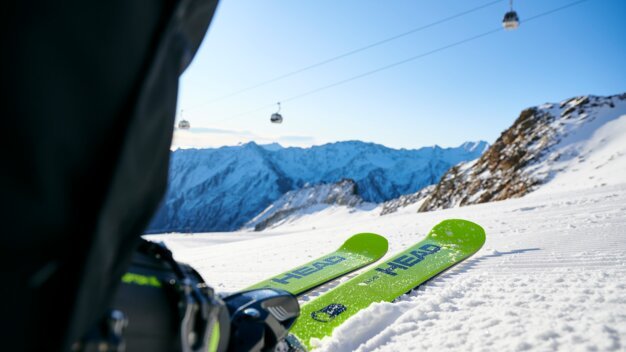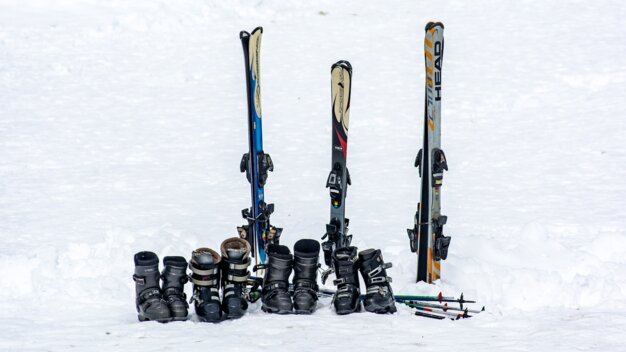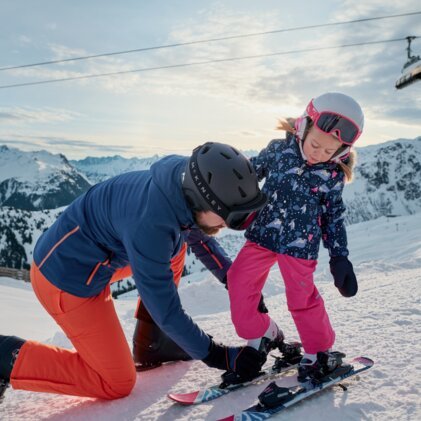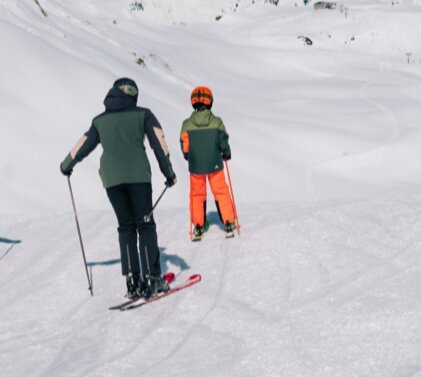
You only realise how important a well-fitting ski boot is when it pinches! To make sure this never happens to you again, we at INTERSPORT Rent have summarised everything you need to know about ski boot sizing, including a size chart.
Size chart for ski boots: Mondopoint
Ski boot sizing is standardised using the Mondopoint (MP) system. This system measures the length of the foot in centimetres and ensures consistent sizing across all brands.
Take your exact foot length in centimetres and compare it to the Mondopoint values in the following ski boot size chart.
|
MP |
EU | UK |
MP |
EU | UK | |
| 15.5 | 25 | 7.5 | 26.0 | 40.5 | 7.0 | |
| 16.5 | 26.5 | 8.5 | 26.5 | 41 | 7.5 | |
| 17.0 | 27.5 | 9.0 | 27.0 | 42 | 8.0 | |
| 17.5 | 28 | 10.0 | 27.5 | 42.5 | 8.5 | |
| 18.5 | 29 | 11.0 | 28.0 | 43 | 9.0 | |
| 19.5 | 30.5 | 12.0 | 28.5 | 44 | 9.5 | |
| 20.0 | 31 | 13.0 | 29.0 | 44.5 | 10.0 | |
| 20.5 | 32 | 1.0 | 29.5 | 45 | 10.5 | |
| 21.0 | 33 | 2.0 | 30.0 | 45.5 | 11.0 | |
| 21.5 | 34 | 3.0 | 30.5 | 46 | 11.5 | |
| 22.0 | 35 | 3.5 | 31.0 | 47 | 12.0 | |
| 22.5 | 36 | 4.0 | 31.5 | 47.5 | 12.5 | |
| 23.0 | 36.5 | 4.5 | 32.0 | 48 | 13.5 | |
| 23.5 | 37 | 5.0 | 32.5 | 48.5 | 13.5 | |
| 24.0 | 38 | 5.5 | 33.0 | 49 | 14.0 | |
| 24.5 | 38.5 | 6.0 | 33.5 | 50 | 14.5 | |
| 25.0 | 39 | 6.5 | 34.0 | 51 | 15.0 | |
| 25.5 | 40 | 7.0 |
Mondopoint vs. boot size: What's the difference?
As mentioned above, the Mondopoint system measures the length of the foot in centimetres and is the only standardised size system for ski boots. A value like MP 27.0 means Your foot is exactly 27 cm long, regardless of the brand. EU boot sizes, on the other hand, are not standardised. That's why the classification in the chart is only a guideline. If you want to be on the safe side, measure your foot and choose the ski boot size based on the Mondopoint.
Ski boot size: the last width
In addition to length, the width of your feet is also important. The last width measures the widest part of your foot, usually at the metatarsophalangeal joint. It is best to check your feet barefoot, and if one is wider than the other, always use the larger value as a guide. Good to know: Women's ski boots often have narrower lasts and special fits that are tailored to the female foot anatomy.
For most ski boots, three last widths are produced for each Mondopoint size:
- LV - Low Volume (narrow): This is a tighter fit for athletic skiers or smaller feet.
- MV - Mid Volume (medium): This standard shape is the most common fit.
- HV - High Volume (wide): This wide version is ideal for larger or wider feet.
Tip: Always buy or rent ski boots that fit snugly, as the padding of the inner boot will give way and expand by up to half a size after a few days on the slopes. It is especially important that the boot is tight but not too much. If it is too loose, control of the skis can be significantly impaired.
How your skiing style influences the choice of the right ski boot size
Choosing the right ski boot size is crucial for comfort and performance on the slopes - and it depends on your skiing style, among other things! Whether you are a relaxed carver or an adrenaline junkie influences not only the size, but also the type that suits you. That's why you'll often be asked about your preferred skiing style when renting or buying ski boots.
The most important types of ski boots at a glance:
- Relaxed carvers: Comfortable with a soft flex
- Sporty racers: Tight fit and hard shell for maximum control
- Touring ski boots: Lightweight and flexible with a walking function for ascents
- Women's ski boots: Tight fit and additional comfort for sensitive feet
- Performance ski boot: Comfort and stability for long days on the slopes
- Children's ski boots: Growing boots with extra protection and easy entry
- Freerider: Stable and durable with a harder flex for deep powder adventures
Flex index and choosing the right ski boot size
The flex index describes how stiff the shaft is when moving forwards. It is another important factor when choosing the right ski boots. The higher the flex index, the greater the resistance on the shin. This provides more control and precise power transfer to the ski, but limits ankle mobility.
Important to know: The flex value is not standardised and can vary depending on the manufacturer. Temperatures also play a role. In cold weather, the stiffness can increase up to 20 %.
The flex index that is right for you depends on your skill level, riding style, and weight. A high value (e.g. from 100) is suitable for experienced skiers and racers who are looking for maximum stability and control. Beginners and recreational skiers, on the other hand, benefit from a lower flex (e.g. 60-90), which offers more comfort and cushioning.
Pro tip: In addition to size, look also at flex and technical features to find the perfect boot for your skiing style.!
For professional advice, we recommend a visit to one of our INTERSPORT Rent locations, where you can try out different models.
Innovative technology in modern ski boots
Today's ski boots are high-tech marvels! Thanks to innovative materials such as brushed polyamide, they protect your feet from impact while offering great comfort. Adjustable aluminium cantings ensure a perfect fit and improve the wearing comfort - both on the slopes and during après-ski.
The latest models are not only lightweight and durable but also offer advanced technologies that make skiing safer and more enjoyable. With equipment from INTERSPORT Rent, you always have access to the latest products that suit your needs and your ideal ski boot size.
Perfect fit with customised ski boot adjustment
Customised ski boots ensure the best fit, optimum comfort and perfect support - crucial for a pleasant and high-performance time on the slopes. During the fitting process, the boot is customised to the shape of your foot so that pressure points and friction are a thing of the past.
Professional customisation not only makes the ski boot more comfortable, but also more functional:
- It supports malpositions such as fallen arches or splayed feet.
- It provides better support, e.g. for narrow feet or wide calves.
- It solves problems that can arise due to other individual foot shapes.
Benefit: The precise boot fitting improves power transmission and gives you more control and stability when skiing.
Take advantage of the boot fitting service at INTERSPORT Rent: Bring your ski boots and get them perfectly fitted for maximum comfort and an unforgettable skiing experience!
Choosing the right ski boot size is the key to comfort, safety and performance on the slopes. From the precise measurement of your foot length using the Mondopoint system to the consideration of skiing style, flex value and technical features, every aspect contributes to a better skiing experience.
Let the experts at INTERSPORT Rent advise you, test different models and enjoy the best that ski boots have to offer with the latest technology - for unforgettable days in the snow!
Frequently asked questions about ski boot size
What is the right ski boot size?
You can determine the right ski boot size using the Mondopoint system (MP), which indicates the foot length in centimetres. To do this, measure both feet barefoot from the heel to the longest toe and orientate yourself on the bigger foot. The width of the last also plays an important role. Also note: The correct fit of the ski boot additionally depends on how you ski! We recommend different models for cosy carvers than for adrenaline junkies. So don't be surprised if you are asked about your skiing style when renting or buying ski boots!
What ski boot size for children?
The size for children's ski boots is also determined by using the Mondopoint system (MP), which is based on foot length in centimetres. It is particularly important that the boots fit snugly enough but do not pinch, as kids’ feet are sensitive. Models with growth-friendly features, such as back entry or adjustable inner shoes, are ideal. Make sure that the boot has the right sole length for the binding and take the time to try them on with ski socks.
How do you know if your boots fit?
A well-fitting ski boot should touch your toes lightly without pinching when you stand. In the skiing position (knees slightly bent), the toes should no longer touch and the heel area should be firmly fixed. There should be no uncomfortable pressure and the boot should not rub anywhere. Always try the boots on with ski socks and make sure that the inner boot expands slightly after a few days.
How often should I check my ski boot size?
Ski boot size should be checked regularly, especially for kids whose feet grow quickly. For adults, it is usually sufficient to test the fit before each ski season, as the padding and shape of ski boots can change over time. If they no longer fit well, it is advisable to make an adjustment or choose a new model.
What should I do if my feet are different sizes?
If your feet are different, always bases your boot size selection on the larger foot. For the smaller one, you can use insoles or thermal adjustments to ensure a perfect fit. In many cases, specialist retailers such as INTERSPORT Rent offer professional boot fitting in order to optimally fit both feet.
INTERSPORT Rent tip
The RENTertainer recommends
What doesn't fit is made to fit! If your boots don't fit perfectly, take them to your nearest INTERSPORT Rent shop on your next ski holiday. Our RENTertainers will make them comfortable again with our boot fitting service!
Of course, you can also rent ski boots, skis and all kinds of winter sports equipment at one of over 800 locations in Europe and Canada - expert advice included!
Related articles
You may also be interested in:
